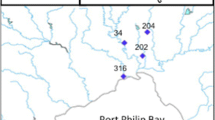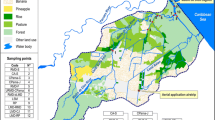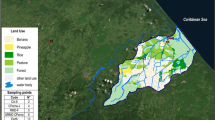Abstract
The goals of this study were to: (1) measure atrazine and metolachlor concentrations during both high and low use periods in the Chesapeake Bay's mainstem/major tributaries, smaller tributaries and representative small agricultural streams during 1995 and 1996; (2) compare these exposure data with toxicity benchmarks for each herbicide to predict ecological risk and (3) use in-stream fish community data collected in the streams to provide supportive data for ecological risk characterization. Spatially, atrazine (<0.10–98 μg/L) and metolachlor (<0.10–68 μg/L) concentrations were highest in the streams, followed by the small tributaries (<0.10–11 μg/L atrazine; <0.10–8.6 μg/L metolachlor) with the lowest concentration in the mainstem Bay/larger tributaries (<0.10–0.22 μg/L atrazine; <0.10–0.24 μg/L metolachlor). Temporally, concentrations of both herbicides were greatest in all three types of habitats in the late spring and early summer. Concentrations of atrazine and metolachlor were very low or non-detectable in all habitats sampled from early August to mid-April. Toxicity benchmarks of 20 μg/L for atrazine based on an ecological No Observed Effect Concentration (NOEC) for microcosm/mesocosm studies and an acute 10th percentile of 53 μg/L for metolachlor (protection of ninety % of the species) based on laboratory toxicity data were selected to assess annual and seasonal ecological risk. Both of these toxicity benchmarks were conservative estimates of ecological risk designed to protect the trophic group (plants) most sensitive to these herbicides. Based on a comparison of these toxicity benchmarks with two years of exposure data, the ecological risk from both atrazine and metolachlor exposure in the mainstem Chesapeake Bay/large tributaries, small tributaries and representative agriculturally dominated streams was generally judged to be low. During one 72-h stream rain event in 1995, the atrazine toxicity benchmark (20 μg/L) was exceeded during part of the event. However, long-term permanent ecological effects are not expected based on the documented recovery potential of the most sensitive trophic group (plant communities) to the concentrations of atrazine reported and the transient nature of the atrazine pulses. Fish communities at the stream sites receiving the highest concentrations of both herbicides were judged to be healthy based on an Index of Biotic Integrity (IBI) developed for Maryland's coastal plain.
Similar content being viewed by others
References
Blankenship, K.: 1997, ‘1996 wettest year on record for flows to Chesapeake’, Bay Journal 7, 7.
CEC (Chesapeake Executive Council): 1989, Chesapeake Bay Toxics Reduction Strategy’, Chesapeake Bay Agreement Commitment Report, Chesapeake Bay Liaison Office, Annapolis, Maryland.
Hall, L. W. Jr., Fischer, S. A., Killen, W. D., Ziegenfuss, M. C., Anderson, R. D. and Klauda, R. J.:1992, 1991 doser study in Maryland coastal plain: Use of lime doser to mitigate stream acidification, Report CBRM-AD-93-6, Chesapeake Bay Research and Monitoring Program, Maryland Department of Natural Resources, Annapolis, Maryland.
Hall, L. W. Jr., Killen, W. D. Scott, M. C. Kilian, J. and Speir, C.: 1966, The 1995 Maryland Biological Stream Survey in two coastal plain rivers basins, Report, Chesapeake and Watershed Assessment Administration, Maryland Department of Natural Resources, Annapolis, Maryland.
Hall, L. W. Jr., Scott, M. C. Killen, W. D. and Anderson, R. D.: 1995, A pilot study to evaluate biological, physical, chemical and land-use characteristics in Maryland coastal plain streams, Final Report CBRM-AD-95-8, Chesapeake Bay Research and Monitoring Division, Maryland Department of Natural Resources, Annapolis, Maryland.
Hall, L. W. Jr., Fischer, S. A. Killen, W. D., Scott, M. C., Ziegenfuss, M. C. and Anderson, R. D.: 1994, Pilot study to evaluate biological, physical, chemical and land-use characteristics in Maryland coastal plain streams, Final report CBRM-AD-94-1, Chesapeake Research and Monitoring Division, Maryland Department of Natural Resources, Annapolis, Maryland.
Hall, L. W. Jr., Anderson, R. D. and Kilian, J.: 1997, Monitoring of atrazine and metolachlor in the mainstem, major tributaries and small streams of the Chesapeake Bay watershed: Implications for ecological risk, Final Report, University of Maryland, Wye Research and Education Center, Queenstown, Maryland.
Johnson, W. E., Kroll, R. B., Pait, A. S. and Plimmer, J. R.: 1994, in S. Nelson and P. Elliot (eds), The Occurrence and Distribution of Pesticides in the Chesapeake Bay, 1994, Advance in Estuarine Sciences, Scientific and Technical Advisory Committee, Chesapeake Bay Program, CRC Pub. No. 147, Annapolis, Maryland.
Karr, J. R., Toth, A. and Dudley, D. R.: 1985, ‘Fish communities of midwestern rivers: A history of degradation’, Bioscience 35, 90–95.
Kroll, R. B. and Murphy, D. L.: 1994, Pilot monitoring for 14 pesticides in Maryland surface waters, Report CBT/TRS 106/94, U.S. Environmental Protection Agency, Chesapeake Bay Program, Annapolis, Maryland.
Maryland Office of Planning: 1991, Maryland's land 1973 – 1990 A changing resource, Publication 91–8, Office of State Planning, Baltimore, Maryland.
Society of Environmental Toxicology and Chemistry (SETAC): 1994, Aquatic risk assessment and mitigation dialogue group, Final report, SETAC Foundation for Environmental Education, Pensacola, Florida.
Solomon, K. R., Baker, D. B., Richards, R. P., Dixon, K. R., Klaine, S. J., LaPoint, T. M., Kendall, R. J., Weiskopf, C. P., Giddings, J. M., Giesey, J. P., Hall, L. W. Jr. and Williams, M.: 1996, ‘Ecological risk assessment of atrazine in North American surface waters’, Environ. Tox. Chem. 15, 31–76.
Solomon, K. R. and Chappel, M. J.: 1996, An ecological risk assessment of metolachlor residues found in various surface water locations, Draft Report, Novartis Crop Protection, Greensboro, North Carolina.
Stratton, G. E.: 1984, ‘Effects of the herbicide atrazine and its degradation products, along and in combination on phototrophic microorganisms’, Arch. Environ. Contam. Toxicol. 13, 35–42.
U.S. EPA (United States Environmental Protection Agency): 1991, Chesapeake Bay Toxics of Concern List, Report prepared by the Chesapeake Bay Program Toxics Subcommittee's Living Resources Subcommittee's Joint Criteria and Standards Workgroup, Annapolis, Maryland.
U.S. EPA (United States Environmental Protection Agency): 1992, Framework for ecological risk assessment, EPA/630/R92/001, Risk Assessment Forum, Washington, DC.
Author information
Authors and Affiliations
Corresponding author
Rights and permissions
About this article
Cite this article
Hall, L.W., Anderson, R.D., Kilian, J. et al. Concurrent Exposure Assessments of Atrazine and Metolachlor in the Mainstem, Major Tributaries and Small Streams of the Chesapeake Bay Watershed: Indicators of Ecological Risk. Environ Monit Assess 59, 155–190 (1999). https://doi.org/10.1023/A:1006188923956
Issue Date:
DOI: https://doi.org/10.1023/A:1006188923956




